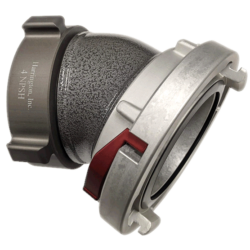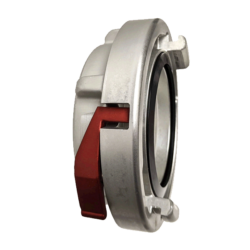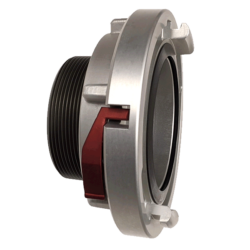Why Harrington?
Harrington’s unique Metal Face Storz adapters are tamper-resistant, so vandals do not take the cap off and shove debris into the pipe. In addition, Harrington FDC adapters do not require locks – another possible failure point. All Harrington FDC adapters are anodized for corrosion resistance and long life. If an elbow is required, Harrington’s elbows are anodized and then powder coated for long life and a quality finish. Available in any size and configuration needed. Harrington FDC Connections are Made in USA with Made in USA aluminum!
What are FDC Connections, and What Do They Do?
An FDC Connection- Fire Department Connection – serves as a connection point for the fire department to pump water into the sprinkler system, standpipe, or other building fire water systems. This additional water supply plays a vital role in enhancing the effectiveness of the fire-extinguishing process.
In case of a fire, the local fire department connects its discharge hose line to the FDC Connection, ensuring a continuous and pressurized water supply to meet the demands and suppress the fire. The presence of an FDC Connection is crucial in scenarios where in-house water supply must be enhanced to support and maintain adequate water supply.
Importance of FDC Installation
The absence of FDC Connections significantly reduces the efficacy of your fire suppression system. In commercial buildings and all fire sprinkler and standpipe systems, NFPA 13 and NFPA 14 mandate the installation of an FDC. This requirement underscores its pivotal role in preventing the complete loss of your facility.
Where Is an FDC Connection Located?
Typically situated on the exterior of a facility, FDC Connections may also be placed separately from the building in some instances. Regardless of location, clear signage indicating whether the FDC supplies a fire sprinkler or standpipe system is mandatory. The sign should also specify the required pressure and whether it serves the entire facility or a designated portion.
Components of an FDC Connection
Most FDCs feature pipes extending from the building’s exterior with older systems having a double inlet clappered wye with 2 each 2.5” female swivels. This configuration has flow limitations and requires 2 hoses and more critical time. Newer installations have 1 each LDH – large diameter hose – Storz connection. This requires only one hose and reduces time to make connections, , and increases flows considerably. The FDC connects to an inlet pipe behind the building’s wall, linking with the existing sprinkler system or standpipe riser. Additionally, FDCs incorporate a check valve to prevent water backflow and plugs to cover inlet valves, safeguarding against pipe clogging.
FDC Inspections and Service Requirements
NFPA regulations mandate regular inspections, tests, and maintenance for FDC Connections, with specific requirements based on the type of fire suppression system in use. Inspection and service tasks include hydrostatic testing, main drain tests, and leak inspections to ensure optimal FDC Connections and system functionality.
In summary, understanding the role, location, components, and maintenance requirements of FDC Connections is crucial for ensuring the effectiveness of your fire suppression system and, ultimately, the safety of your facility.
Harrington’s connections are engineered to excel in dependability and deliver a lifetime of durability. Shop our most popular FDC Connections:



